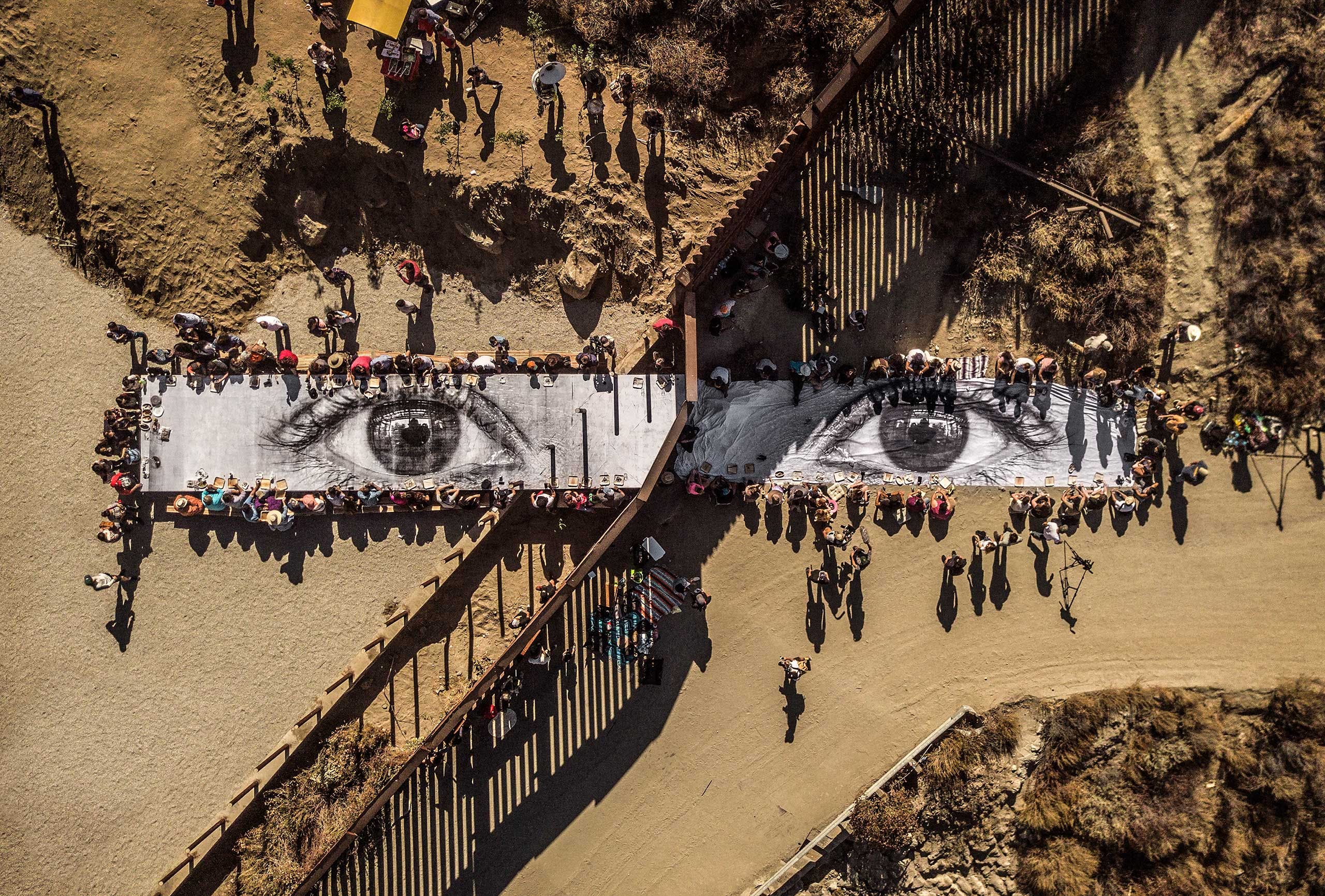‘Walls were my places of expression’: Street artist JR on turning border walls into canvases
In the wake of the US election, French ‘photograffeur’ JR describes his experience of travelling to the Mexico border. Chantal da Silva reports


Since his early days of trying to make his mark on the world as a teenager by graffitiing buildings across Paris, JR, a French self-described “photograffeur”, has been fascinated by walls. “Ever since the beginning, walls were my places of expression,” JR, who has long sought to remain semi-anonymous, even as he is set to launch his biggest exhibition yet at London’s Saatchi Gallery next month, tells The Independent.
While for JR every wall is a potential blank canvas, it is not just the physical boundaries of the world that inspire him, but also the invisible barriers between people and communities around the globe.
Documenting the 2005 riots that saw weeks of unrest over the marginalisation of those living in the suburban banlieues of Paris, JR learned early on just how real society’s intangible barriers can be.
“Growing up in the projects and living through the riots that exploded at the time, I saw the wall that was there,” he says. “Even if it was not physical, there was a wall between Paris and the suburbs. That’s what brought me to want to see what kinds of other physical or virtual walls existed around the world and how they shaped the perceptions that we have of each other.”
It should come as no surprise, then, that as soon as President Donald Trump took office in January 2017, his plans to build a “big, beautiful wall” along the US-Mexico border as part of a sweeping crackdown on illegal immigration immediately caught JR’s attention.
Disturbed by the divisive rhetoric from a president seemingly determined to build barriers, rather than break them down, JR travelled to the border in 2017 to witness the situation there for himself.
“I lived in New York for almost 10 years and it’s something that you don’t realise there [in the US], but each time [you travel to a different state] it feels like going into another country,” he says.
Meeting people on both sides of the border, he recalls, was an eye-opening experience. The artist was particularly moved by one family whose home overlooked the border in the Mexican city of Tecate.
One of his installations, titled Giants, Kikito, which made headlines around the world, was inspired by the family’s toddler.
Using scaffolding on the Mexican side of the border, JR portrayed a blown-up image of Kikito appearing to look down on the barriers erected between the two countries with all the innocent curiosity of a child.
Like the inquisitive infant, JR says he hoped that the installation would inspire people to ask their own questions about the borders that exist between us and what they mean.
“I think as an artist, you raise questions, but you don’t necessarily give answers,” he says. “This little kid lives by the border, but doesn’t really know what a wall is or what a separation wall means. He has no clue.”
The piece, he says, should challenge the “perceptions that we have of the ‘other’”.
“I think the biggest walls that we have are the walls that we have within us,” JR says. “Those are the walls that are the hardest to pass because it happens within us and within the preconceptions that we have of each other and how we see each other.”
In addition to Giants, Kikito, the artist also constructed a fake wall of his own along the border and created a picnic table spanning across both sides. Imprinted across the table were the eyes of Mayra, a “Dreamer” – or an undocumented immigrant brought to the US illegally as a child – JR had met.
Mayra’s inclusion has become particularly poignant over the years given the Trump administration’s attempts to end the Deferred Action for Childhood Arrivals (Daca) programme, which allows Dreamers to live and work in the US.
On the final day of the installation, JR invited residents from both sides of the border to come together for a picnic. Tacos were made on the Mexican side of the border and shared with families across the table, despite the physical barrier keeping them apart.
Last month, the Trump administration celebrated the construction of roughly 400 miles of border wall between the US and Mexico. With the president having promised to see at least 450 miles of it built before the end of 2020 as part of his 2016 campaign, reaching the 400-mile mark was hailed as a major achievement by his supporters.
While JR prefers to raise questions around political leadership, rather than criticise it directly, for Trump he makes an exception, saying: “It’s hard not to have feelings when you see the impact that this president has had.
“These issues were already there, the racism and the hatred … but he has exacerbated them and amplified them.”
Speaking just days before the US election, the artist says that he could not bear the thought of Trump winning a second term in office.
“I don’t want to think about it because it would be a real disaster, not only for the US, but for the world. In the last few years, we have looked at them and looked at Trump almost like a daily show, but the consequences are real and it would be a huge failure of the US if that happened.
“As artists, we try to do our part. I know a lot of artists that are there and that every single day try to do projects to link people together. In this world, we’ll have to do it for the rest of our lives, but in moments like these, it’s more necessary than ever.”
In one powerful display, JR saw the images of women’s faces pasted across homes in the Rio de Janeiro favela of Morro da Providencia
For JR, however, voting Trump out of office is “just the first step” in beginning to address some of the issues afflicting the US and countries around the world head-on. “The first step is definitely to vote him out, but there will be many steps,” he says.
In addition to racial injustice and police brutality against black people, JR says he believes gun violence and women’s rights are among the issues that need to be addressed.
Throughout his career, the artist’s work has also focused on both the latter issues: his series “The Gun Chronicles: A Story of America” was featured in Time magazine in 2018.
For the series, JR traveled to St Louis, Dallas and Washington DC to meet with 245 representatives of a wide range of views on gun rights in the United States, including “gun collectors, hunters, law enforcement officials, emergency room teams that have treated victims of mass shootings, lobbyists and others”.
JR photographed each individual and recorded them sharing their personal accounts and takes on gun rights, and a “video mural” of the project was projected in dozens of museums and locations across the country.
Like much of his work, JR’s hope was to prompt thoughtful discussion around a hot button issue in America.
Meanwhile another series titled “Women are Heroes” saw JR pasting images of women across buildings in a number of cities around the world to shine a light on the critical roles they play as the pillars of their communities.
The artist travelled around the world, initially interested to “see where people would say no” to the project. However, he says: “I went to Sudan, to Kenya, to Cambodia and Brazil and in each of those places, people would not only encourage me to do it, but would also help.”
In one powerful display, JR saw the images of women’s faces pasted across homes in the Rio de Janeiro favela of Morro da Providencia, a place described on the artist’s website as “synonymous for violence” in the city.
“However the reason this favela located in the centre of Rio appeared on television screens in August 2008 wasn’t the regular scenes of clashes between drug dealers and the police, but to present the art exhibition,” his website states.
For JR, going to “physically meet” the subjects of his work has always been an important part of his art. However, the coronavirus pandemic has created a new barrier, forcing the artist to stay put in France.
“Of course, nothing is impossible, so during the pandemic I’ve just adapted my work,” he tells me.
Part of that adaptation has seen JR focus on providing lessons on photography and street art to young and up-and-coming artists through a school he runs “in the projects, where I started”.
“I guess what I’m trying to do is really help artists figure out how to survive as an artist and make a living out of it, so they don’t have to make the mistakes I have,” he says. “I take them right away to exhibitions, to meet the heads of studios and [teach them] how to build projects.”
“To be honest, I didn’t even know I would have a career or even become an artist,” he admits. “When I was growing up, I didn’t realise that ‘artist’ could even be a real job.”
Organised by the Brooklyn Museum, the “JR: Chronicles” exhibition is expected to take place at the Saatchi Gallery in London, starting early next month, depending on coronavirus guidelines




Join our commenting forum
Join thought-provoking conversations, follow other Independent readers and see their replies
Comments